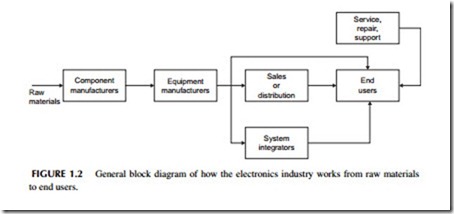HOW THE ELECTRONICS INDUSTRY WORKS
As part of the big picture of learning electronics, you really need to under- stand how the industry itself works. This is summed up by the simplified block diagram in Figure 1.2. It all starts with the raw materials that the component manufacturers use to create the individual components. For example, sand is refined into silicon, which, in turn, is converted into wafers that are processed into the integrated circuits we use.
The electronic equipment manufacturers design the electronic equipment for the marketplace. It may be a TV set, a cell phone, or a military radar. These companies buy the electronic components and put them together to create the
end product. Manufacturers may then sell the end product directly to customers and end users. In some cases, the end product will go through a sales organization or distributor of some sort. Your LCD large-screen TV set doesn’t come directly to you directly from Samsung in Korea or Sony in Japan. It is sold to an organization such as Best Buy or Circuit City, which is where you buy it. Sometimes the electronic equipment is sold to so-called systems inte- grators. These are companies that piece together larger systems for an end user (like the military) made up of a wide range of different types of equipment.
Finally, there are the customers or end users of the equipment. These come from a wide range of backgrounds. The end users or customers may be businesses with offices, industry with factories and process control plants, or the government, military, hospitals and other medical organizations, schools, colleges and universities, and you the consumer. There is also a network of service companies designed to support customers. They may do installation or repair work that the customer is not capable of doing.
Electricity versus Electronics
One of the questions that always comes up in the early stages of learning about electronics is what the difference is between electricity and electronics. Let’s get this straight up front. Electricity refers to the basic energy we use for power. It generally involves the generation and distribution of electrical energy to homes, businesses, and factories. Electricity is energy that is produced by the coal-fired or nuclear power plant and then sent to you over long transmission lines until it comes into your house where you access it through your AC wall outlets. You use that energy for lighting and appliances, and also to power most of your electronic equipment.
Electrical power may also be generated for use in other systems. The electrical system in a car is a great example. It uses a battery plus a generator driven by the automobile engine to recharge the battery and to operate all of the electrical and electronic devices in a car. Ships, airplanes, and off-shore drilling rigs also have their own electrical-power generating systems. The new electric wind generators and solar power systems are also electricity-producing systems.
All of the principles of electricity also apply to electronics. Basic electrical components such as resistors, capacitors, inductors, transformers, motors, and other similar devices are also used in electronics.
Electronics is the field of science that uses electrical principles to per- form other useful functions. Electronics is the control of electricity to produce radio, television, computers, robots, and MRI machines. To control the electricity, you need more than just basic electrical components such as resistors and capacitors. What makes electronics possible are the unique components called transistors. Electronics began, of course, with vacuum tubes and then switched over to transistors as the main control devices. Transistors are now miniaturized and packaged in devices called integrated circuits that perform very specific electronic functions, such as generating signals, amplifying signals, or performing some control function. Just keep in mind that it is the control devices such as transistors and the circuits that they comprise that make electronics what it is. The transistors are used to form circuits that in turn per- form all of the various functions required to produce electronic devices.
